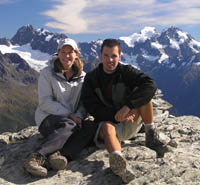GLACIER NATIONAL PARK, MONTANA – “The middle of the food chain is a bad place to be,” I thought, as we happened upon the heaping pile of fresh bear scat in the middle of the trail. Lynn turned to me gravely, “it’s still warm.” Five miles from the nearest road, and suddenly we felt very small.
Glacier National Park in Northwest Montana is one of the crown jewels of the U.S. Park System, and it compares favorably to any mountain landscape on the continent. Designated a National Park in 1909, Glacier was looked upon by the railroad tycoons as a natural draw to lure customers out West. As a result of these two facts, Glacier has always walked the thin line between development and protected wilderness. Five provincial-style lodges dot the glacially carved landscape, and a road was literally carved out of vertiginous rock faces to traverse the Park’s most scenic mountain pass.
Yet, amidst this development, Glacier retains vast swaths of pristine wild land. Huge mountains rise vertically from verdant-river valleys carved long ago by the Park’s namesake glaciers. Old growth forest carpets much of the lowlands, interrupted only by deep-green meadows punctuated with Technicolor wildflowers, while glacier-capped peaks soar overhead. It is a vertical canvas, displaying some of Nature’s best work.
“The tracks up here are kinda small,” I mutter rather hopefully, noting that the print in the mud was every bit as big as my size 11 shoe. Thinking to myself, what do I know -- I just saw my first bear ever from the comfort of a car an hour ago -- I look Lynn in the eye and tentatively say, “I don’t think it is a Grizzly.”
Thanks to the efforts to protect this majestic land, as well as the efforts of our more environmentally conscious neighbors to the North, Glacier National Park is the southern tip of a wilderness corridor that extends far into Canada. As a result, Glacier contains one of the few truly healthy ecosystems in the United States, with a wide variety of flora and fauna, including, deer, elk, mountain lions, moose, wolves, and bears. Yes, lots of bears.
The decision to go backpacking in bear country isn’t as daft as one might think. Thousands of people explore Glacier’s valleys, climb Glacier’s peaks, and paddle Glacier’s waters every year without incident. The Park Rangers monitor bear-activity, and will close a trail if the bears become a threat. Rangers also educate backcountry users about human behavior in bear country, and the use of proper protocol keeps human-bear interaction to a minimum. Bears don’t eat people for food, and in fact want nothing to do with humans. The fact of the matter is that backpacking in Glacier is really quite safe. Nevertheless, still-steaming bear scat on your trail is still scary as hell.
Lynn and I set out yesterday morning from Whitefish for the short drive to West Glacier, Montana. After a quick stop at the backcountry permit office, we eased our car onto the famous Going To The Sun Road. Perhaps the most spectacular 50+ miles of paved road in the country, GTTSR bisects picture-perfect meadows and meandering river valleys before climbing up and over spectacular Logan Pass. On the way it passes numerous waterfalls pounding down steep slopes, and provides outstanding views to numerous sky scraping peaks cloaked in glacial ice.
Awed by the drive through Glacier, we made our way to the Red Eagle Trailhead on the East side of the Park. Our destination was Red Eagle Lake, an easy 7.5 miles into the backcountry. The trail was spectacular, as it passed through wide meadows of swishy tall grasses, knee-deep wildflowers, and fresh berries. We crossed two amazing wooden suspension bridges over Red Eagle Creek, before coming to stop to gaze in wonder at a big pile of shit.
“What should we do?”
“What can we do? Keep walking.”
We continued on without incident, talking loudly and periodically clapping, so as not to surprise our friend. The next two days were amazing. We watched deer frolic on the beach, loons glide across the surface of the lake, and cutthroat trout cruise the shallows. We swam, fly-fished, hiked, and relaxed in an amazing amphitheater of high peaks. It rained quite a bit, but that didn’t dampen our enthusiasm for “our” amazing mountain valley.
Day 3 & 4 Road Trip Factoids:
Miles Driven Today and Yesterday: 75
Miles Driven Total: 705
Miles Hiked: 16
Bears Seen from Car: 5 (3 Grizzlies, 2 Black Bears)
Bears Seen on Trail: 0
Fish Caught: A few, but not enough...
Enjoy the
Glacier National Park Photos.
